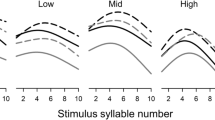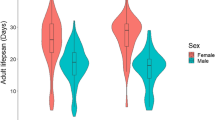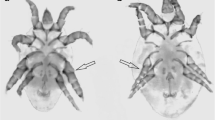Abstract
Inter-individual variation in lifetime reproduction is the key target for natural selection, and it is influenced by many factors. Yet, we lack an understanding of how abiotic and biotic factors interact to influence lifetime reproductive output (number of offspring) and reproductive effort (total biomass invested into reproduction). Thus, we used a factorial design to manipulate variability in food availability and temperature while also accounting for mate quality. We tested hypotheses related to estimates of lifetime reproductive output and effort in females of the wing-dimorphic sand field cricket (Gryllus firmus). Environmental variability influenced a temporal tradeoff of reproduction because females experiencing fluctuating temperatures had a particular bias toward reproductive output during early adulthood. Also, complex environmental variability (i.e., multiple and co-varying environmental factors) influenced differential allocation, which is when individuals adjust their reproductive efforts according to mate quality. Females mated to higher quality males laid more eggs only in environments that were highly stable (constant temperature and ad libitum food access). Reproductive effort was affected by a food–temperature interaction—fluctuating temperatures promoted egg production when food was limited, while constant temperature promoted egg production when food was abundant. Although a wing dimorphism mediates a well-established flight–fecundity tradeoff during early adulthood in G. firmus, short- and long-winged morphs exhibited similar lifetime reproduction and responded similarly to complex environmental variability. Given the natural co-variation of many environmental factors (e.g., water limitation often accompanies heat waves), we encourage continued work examining the role of complex environmental variability in tradeoffs related to reproductive decision-making and allocation.
Significance statement
It is unclear how abiotic and biotic factors interact to influence lifetime reproductive output (number of offspring) and reproductive effort (total biomass invested into reproduction). Thus, we examined the effects of mate quality and complex environmental variability (variable food and temperature) on several metrics of lifetime reproduction. Female crickets mated to high-quality males had greater reproductive output, but only in highly stable or environmental conditions. Fluctuating temperatures biased reproductive output toward early adulthood, particularly in short-winged females. Reproductive effort was affected by a food–temperature interaction—fluctuating temperatures promoted egg production when food was limited, while constant temperature promoted egg production when food was abundant. Females can also retain unfertilized eggs, and egg retention (i.e., unrealized fitness potential) was influenced by a combination of mate quality and complex environments. Thus, it is important to carefully consider the interplay between biotic and abiotic factors in aspects of lifetime reproduction and reproductive decision-making.




Similar content being viewed by others

Data availability statement
The datasets generated and analyzed during the current study are available from the corresponding author on reasonable request.
References
Adamo SA, Hoy RR (1995) Agonistic behavior in male and female field crickets, GRYLLUS-BIMACULATUS, and how behavioral context influences its expression. Anim Behav 49:1491–1501
Adamo SA, Baker JL, Lovett MME, Wilson G (2012) Climate change and temperate zone insects: the tyranny of thermodynamics meets the world of limited resources. Environ Entomol 41:1644–1652
Alexander RD (1961) Aggressiveness, territoriality, and sexual behavior in field crickets (Orthoptera: Gryllidae). Behaviour 17:130–223
Anderson JL, Albergotti L, Ellebracht B, Huey RB, Phillips PC (2011) Does thermoregulatory behavior maximize reproductive fitness of natural isolates of Caenorhabditis elegans? BMC Evol Biol 11:157
Andersson M (1994) Sexual selection. Princeton University Press, Princeton
Angilletta MJ (2009) Thermal adaptation: a theoretical and empirical synthesis. University Press, Oxford
Boggs CL, Ross CL (1993) The effect of adult food limitation on life history traits in Speyeria mormonia (Lepidoptera: Nymphalidae). Ecology 74:433–441
Both C, Visser ME (2005) The effect of climate change on the correlation between avian life-history traits. Glob Chang Biol 11:1606–1613
Bretman A, Rodriguez-Munoz R, Tregenza T (2006) Male dominance determines female egg laying rate in crickets. Biol Lett 2:409–411
Brockelman WY (1975) Competition, the fitness of offspring, and optimal clutch size. Am Nat 109:677–699
Brommer JE (2000) The evolution of fitness in life-history theory. Biol Rev 75:377–404
Burley N (1986) Sexual selection for aesthetic traits in species with biparental care. Am Nat 127:415–445
Capinera JL, Scott RD, Walker TJ (2004) Field guide to grasshoppers, crickets, and katydids of the United States. Cornell University Press, Ithaca
Carriere Y, Roff DA (1995) The evolution of offspring size and number - a test of the Smith-Fretwell model in three species of crickets. Oecologia 102:389–396
Charmantier A, McCleery RH, Cole LR, Perrins C, Kruuk LEB, Sheldon BC (2008) Adaptive phenotypic plasticity in response to climate change in a wild bird population. Science 320:800–803
Clutton-Brock TH (1984) Reproductive effort and terminal investment in iteroparous animals. Am Nat 123:212–229
Cody ML (1966) A general theory of clutch size. Evolution 20:174–184
Connallon T, Hall MD (2016) Genetic correlations and sex-specific adaptation in changing environments. Evolution 70:2186–2198
Crnokrak P, Roff DA (1995) Fitness differences associated with calling behaviour in the two wing morphs of male sand crickets, Gryllus firmus. Anim Behav 50:1475–1481
Cronin AD, Ryan MJ, Page RA et al (2019) Environmental heterogeneity alters mate choice behavior for multimodal signals. Behav Ecol Sociobiol 73:43
Darling ES, Cote IM (2008) Quantifying the evidence for ecological synergies. Ecol Lett 11:1278–1286
Dillon ME, Woods HA, Wang G, Fey SB, Vasseur DA, Telemeco RS, Marshall K, Pincebourde S (2016) Life in the frequency domain: the biological impacts of changes in climate variability at multiple time scales. Integr Comp Biol 56:14–30
Douhard M, Loe LE, Stien A, Bonenfant C, Irvine RJ, Veiberg V, Ropstad E, Albon S (2016) The influence of weather conditions during gestation on life histories in a wild Arctic ungulate. Proc R Soc Lond B 283:20161760
Duffield KR, Bowers EK, Sakaluk SK, Sadd BM (2017) A dynamic threshold model for terminal investment. Behav Ecol Sociobiol 71:185
Eraly D, Hendrickx F, Lens L (2009) Condition-dependent mate choice and its implications for population differentiation in the wolf spider Pirata piraticus. Behav Ecol 20:856–863
Evans JP, Garcia-Gonzalez F (2016) The total opportunity for sexual selection and the integration of pre- and post-mating episodes of sexual selection in a complex world. J Evol Biol 29:2338–2361
Fisher HS, Rosenthal GG (2006) Hungry females show stronger mating preferences. Behav Ecol 17:979–981
Flatt T, Heyland A (2011) Mechanisms of life history evolution the genetics and physiology of life history traits and trade-offs. Oxford University Press, Oxford
Fox CW, Moya-Larano J (2009) Diet affects female mating behaviour in a seed-feeding beetle. Physiol Entomol 34:370–378
Gershman SN (2010) Large numbers of matings give female field crickets a direct benefit but not a genetic benefit. J Insect Behav 23:59–68
Glass JR, Stahlschmidt ZR (2019) Should I stay or should I go? Complex environments influence the developmental plasticity of flight capacity and flight-related trade-offs. Biol J Linn Soc blz073. https://doi.org/10.1093/biolinnean/blz073
Gotthard K, Berger D, Walters R (2007) What keeps insects small? Time limitation during oviposition reduces the fecundity benefit of female size in a butterfly. Am Nat 169:768–779
Gowaty PA (2008) Reproductive compensation. J Evol Biol 21:1189–1200
Guerra P (2011) Evaluating the life-history trade-off between dispersal capability and reproduction in wing dimorphic insects: a meta-analysis. Biol Rev 86:813–835
Haaland TR, Wright J, Kuijper B, Ratikainen II (2017) Differential allocation revisited: when should mate quality affect parental investment? Am Nat 190:534–546
Harris WE, Uller T (2009) Reproductive investment when mate quality varies: differential allocation versus reproductive compensation. Philos Trans R Soc B 364:1039–1048
Harshman LG, Zera AJ (2007) The cost of reproduction: the devil in the details. Trends Ecol Evol 22:80–86
Hastings A, Caswell H (1979) Role of environmental variability in the evolution of life history strategies. Proc NatI Acad Sci U S A 76:4700–4703
Hervé C, Brent JS, Philippe V, David R (2015) Insects in Fluctuating Thermal Environments. Annual Review of Entomology 60:1, 123–140
Honek A (1993) Intraspecific variation in body size and fecundity in insects – a general relationship. Oikos 66:483–492
Horvathova T, Nakagawa S, Uller T (2012) Strategic female reproductive investment in response to male attractiveness in birds. Proc R Soc Lond B 279:163–170
Kaunisto S, Ferguson LV, Sinclair BJ (2016) Can we predict the effects of multiple stressors on insects in a changing climate? Curr Opin Insect Sci 17:55–61
King EG, Roff DA, Fairbairn DJ (2011) Trade-off acquisition and allocation in Gryllus firmus: a test of the Y model. J Evol Biol 24:256–264
Kirk KL (1997) Life-history responses to variable environments: starvation and reproduction in planktonic rotifers. Ecology 78:434–441
Kjesbu OS, Witthames PR, Solemdal P, Walker MG (1998) Temporal variations in the fecundity of Arcto-Norwegian cod (Gadus morhua) in response to natural changes in food and temperature. J Sea Res 40:303–321
Kleinteich A, Wilder SM, Schneider JM (2015) Contributions of juvenile and adult diet to the lifetime reproductive success and lifespan of a spider. Oikos 124:130138
Korpimaki E, Wiehn J (1998) Clutch size of kestrels: seasonal decline and experimental evidence for food limitation under fluctuating food conditions. Oikos 83:259–272
Lemaitre JF, Berger V, Bonenfant C, Douhard M, Gamelon M, Plard F, Gaillard JM (2015) Early-late life trade-offs and the evolution of ageing in the wild. Proc R Soc Lond B 282:20150209
Lierheimer VF, Tinghitella RM (2017) Quantity and quality of available mates alters female responsiveness but not investment in the Pacific field cricket, Teleogryllus oceanicus. Behav Ecol Sociobiol 71:80
Long TAF, Agrawal AF, Rowe L (2012) The effect of sexual selection on offspring fitness depends on the nature of genetic variation. Curr Biol 22:204–208
Lorch PD, Proulx S, Rowe L, Day T (2003) Condition-dependent sexual selection can accelerate adaptation. Evol Ecol Res 5:867–881
Magnhagen C (1991) Predation risk as a cost of reproduction. Trends Ecol Evol 6:183–185
McBryan TL, Anttila K, Healy TM, Schulte PM (2013) Responses to temperature and hypoxia as interacting stressors in fish: implications for adaptation to environmental change. Integr Comp Biol 53:648–659
Mole S, Zera AJ (1994) Differential resource consumption obviates a potential flight fecundity trade-off in the sand cricket (GRYLLUS-FIRMUS). Funct Ecol 8:573–580
Moskalik B, Uetz GW (2011) Female hunger state affects mate choice of a sexually selected trait in a wolf spider. Anim Behav 81:715–722
Nguyen K, Stahlschmidt ZR (2019) When to fight? Disentangling temperature and circadian effects on aggression and agonistic contests. Anim Behav 148:1–8
Orzack SH, Tuljapurkar S (2001) Reproductive effort in variable environments, or environmental variation IS for the birds. Ecology 82:2659–2665
Peters RH (1983) The ecological implications of body size. Cambridge University Press, Cambridge
Rantala MJ, Kortet R (2004) Male dominance and immunocompetence in a field cricket. Behav Ecol 15:187–191
Ratikainen II, Kokko H (2010) Differential allocation and compensation: who deserves the silver spoon? Behav Ecol 21:195–200
Roff DA (1994) Habitat persistence and the evolution of wing dimorphism in insects. Am Nat 144:772–798
Roff DA (2002) Life history evolution. Sinauer Press, Sunderland
Roff DA, Gelinas MB (2003) Phenotypic plasticity and the evolution of trade-offs: the quantitative genetics of resource allocation in the wing dimorphic cricket, Gryllus firmus. J Evol Biol 16:55–63
Royle NJ, Smiseth PT, Kolliker M (2012) The evolution of parental care. Oxford University Press, Oxford
Saleh NW, Larson EL, Harrison RG (2014) Reproductive success and body size in the cricket Gryllus firmus. J Insect Behav 27:346–356
Sears MW, Angilletta MJ, Schuler MS, Borchert J, Dilliplane KF, Stegman M, Rusch TW, Mitchell WA (2016) Configuration of the thermal landscape determines thermoregulatory performance of ectotherms. Proc Natl Acad Sci U S A 113:10595–10600
Sheldon BC (2000) Differential allocation: tests, mechanisms and implications. Trends Ecol Evol 15:397–402
Shine R (1988) The evolution of large body size in females: a critique of Darwin's ‘fecundity advantage’ model. Am Nat 131:124–131
Shoemaker KL, Adamo SA (2007) Adult female crickets, Gryllus texensis, maintain reproductive output after repeated immune challenges. Physiol Entomol 32:113–120
Simmons LW (1986) Inter-male competition and mating success in the field cricket, Gryllus bimaculatus (De Geer). Anim Behav 34:567–579
Slatyer RA, Mautz BS, Backwell PRY, Jennions MD (2012) Estimating genetic benefits of polyandry from experimental studies: a meta-analysis. Biol Rev 87:1–33
Smith CC, Fretwell SD (1974) Optimal balance between size and number of offspring. Am Nat 108:499–506
Stahlschmidt ZR, Adamo SA (2013) Warm and cozy: temperature and predation risk interactively affect oviposition-site selection. Anim Behav 86:553–558
Stahlschmidt ZR, Adamo SA (2015) Food-limited mothers favour offspring quality over offspring number: a principal components approach. Funct Ecol 29:88–95
Stahlschmidt ZR, DeNardo DF (2010) Parental behavior in pythons is responsive to both the hydric and thermal dynamics of the nest. J Exp Biol 213:1691–1696
Stahlschmidt ZR, Brashears J, DeNardo DF (2011) The role of temperature and humidity in python nest site selection. Anim Behav 81:1077–1081
Stahlschmidt ZR, Rollinson N, Acker M, Adamo SA (2013) Are all eggs created equal? Food availability and the fitness trade-off between reproduction and immunity. Funct Ecol 27:800–806
Stahlschmidt ZR, O'Leary ME, Adamo SA (2014) Food limitation leads to risky decision-making and to tradeoffs with oviposition. Behav Ecol 25:23–27
Stahlschmidt ZR, Acker M, Kovalko I, Adamo SA (2015) The double-edged sword of immune defence and damage control: Do food availability and immune challenge alter the balance? Functional Ecology. 29, 1445–1452
Stamp NE (1993) A temperate region view of the interaction of temperature, food quality, and predators on caterpillar foraging. In: Stamp NE, Casey TM (eds) Caterpillars: ecological and evolutionary constraints on foraging. Chapman and Hall, New York
Stearns SC (1992) Evolution of life histories. Oxford University Press, New York
Strambi A, Strambi C, Cayre M (1997) Hormonal control of reproduction and reproductive behavior in crickets. Arch Insect Biochem Physiol 35:393–404
Todgham AE, Stillman JH (2013) Physiological responses to shifts in multiple environmental stressors: relevance in a changing world. Integr Comp Biol 53:539–544
van Noordwijk AJ, de Jong G (1986) Acquisition and allocation of resources: their influence on variation in life history tactics. Am Nat 128:137–142
Vedenina VY, Shestakov LS (2018) Loser in fight but winner in love: how does inter-male competition determine the pattern and outcome of courtship in cricket Gryllus bimaculatus? Front Ecol Evol 6:197
Wheeler D (1996) The role of nourishment in oogenesis. Annu Rev Entomol 41:407–431
Whitlock MC, Agrawal AF (2009) Purging the genome with sexual selection: reducing mutation load through selection on males. Evolution 63:569–582
Williams GC (1966) Natural selection, the costs of reproduction, and a refinement of Lack's principle. Am Nat 100:687–690
Wootton RJ (1979) Energy cost of egg reproduction and environmental determinants of fecundity in teleost fishes. Symp Zool Soc Lond 44:133–159
Worthington AM, Kelly CD (2016) Direct costs and benefits of multiple mating: are high female mating rates due to ejaculate replenishment? Behav Process 124:115–122
Wynn H, Vahed K (2004) Male Gryllus bimaculatus guard females to delay them from mating with rival males and to obtain repeated copulations. J Insect Behav 17:53–66
Zammuto RM, Millar JS (1985) Environmental predictability, variability, and Spermophilus columbianus life history over an elevational gradient. Ecology 66:1784–1794
Zera AJ (2005) Intermediary metabolism and life history trade-offs: lipid metabolism in lines of the wing-polymorphic cricket, Gryllus firmus, selected for flight capability vs. early age reproduction. Integr Comp Biol 45:511–524
Zera AJ, Cisper G (2001) Genetic and diurnal variation in the juvenile hormone titer in a wing-polymorphic cricket: implications for the evolution of life histories and dispersal. Physiol Biochem Zool 74:293–306
Zera AJ, Denno RF (1997) Physiology and ecology of dispersal polymorphism in insects. Annu Rev Entomol 42:207–230
Zera AJ, Harshman LG (2001) The physiology of life history trade-offs in animals. Annu Rev Ecol Syst 32:95–126
Zera AJ, Sall J, Grudzinski K (1997) Flight-muscle polymorphism in the cricket Gryllus firmus: muscle characteristics and their influence on the evolution of flightlessness. Physiol Zool 70:519–529
Zera AJ, Zhao Z, Kaliseck K (2007) Hormones in the field: evolutionary endocrinology of juvenile hormone and ecdysteroids in field populations of the wing-dimorphic cricket Gryllus firmus. Physiol Biochem Zool 80:592–606
Acknowledgments
We thank Andy Byeon, Grace Cho, Jordan Glass, Stephanie Ha, Narin Jeong, David Luc, Garrett Masuda, Katherine Nguyen, and Carolyn Pak for animal care and/or experimental assistance. We also appreciate feedback on the manuscript from Jordan Glass, Dustin Johnson, and an anonymous reviewer.
Funding
This study was financially supported by the National Science Foundation (IOS-1565695 to ZRS) and University of the Pacific (to ZRS).
Author information
Authors and Affiliations
Corresponding author
Additional information
Communicated by K. Shaw
Publisher’s note
Springer Nature remains neutral with regard to jurisdictional claims in published maps and institutional affiliations.
Electronic supplementary material
ESM 1
(DOCX 23 kb)
Rights and permissions
About this article
Cite this article
Stahlschmidt, Z.R., Chu, I. & Koh, C. When do looks matter? Effects of mate quality and environmental variability on lifetime reproduction. Behav Ecol Sociobiol 74, 11 (2020). https://doi.org/10.1007/s00265-019-2790-9
Received:
Revised:
Accepted:
Published:
DOI: https://doi.org/10.1007/s00265-019-2790-9



